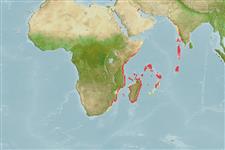Classification / Names
ชื่อสามัญ | ชื่อพ้อง | Catalog of Fishes(สกุล, ชนิด) | ITIS | CoL | WoRMS | Cloffa
>
Acropomatiformes (Oceanic basses) >
Pempheridae (Sweepers)
Etymology: Parapriacanthus: Greek, para = near + Greek, prion = saw + Greek, akantha = thorn (Ref. 45335); punctulatus: Name from Latin 'punctulatus' for dotted; referring to the profusion of dark dots on the side of the body below the lateral line that extend well posterior to the origin of the anal fin; these dots are more evident on preserved specimens than in life..
Environment: milieu / climate zone / depth range / distribution range
นิเวศวิทยา
เกี่ยวกับทะเล,น้ำเค็ม เกี่ยวกับหินโสโครก; ระดับความลึก 16 - 61 m (Ref. 107896). Tropical
การแพร่กระจาย
ประเทศต่างๆ | พื้นที่จำแนกตาม FAO | ระบบนิเวศหลายระบบ | การปรากฏขึ้น,การเกิดขึ้น,พบ | Point map | การแนะนำ | Faunafri
Western Indian Ocean: wide-ranging from South Africa (KwaZulu-Natal) and Mozambique to the Comoro Islands, northern Madagascar, Seychelles, the Mascarene Ridge, and the Mascarene Island of Réunion.
ขนาด / น้ำหนัก / Age
Maturity: Lm ? range ? - ? cm
Max length : 6.7 cm SL เพศผู้/กระเทย; (Ref. 107896); 5.0 cm SL (female)
Short description
เครื่องมือที่ใช้ในการแยกชนิดสัตว์,สิ่งมีชีวิตออกจากกัน | สัณฐานวิทยา | ความยาวต่างๆ
เงี่ยงครีบหลัง (รวม) : 6; ก้านครีบอ่อนที่หาง (รวม) : 9; เงี่ยงครีบก้น: 3; ก้านครีบอ่อนที่ก้น: 20 - 23. This species is characterized by the following: D VI,9; A III,21 (20-23); pectoral-fin rays 16 (15-17); lateral-line scales 69 (63-72); scale rows above lateral line to base of dorsal fin 5.5; gill rakers 24 (23-26, modally 25); body depth 3.2 (3.25-3.35) in SL, width 2.1 (2.0-2.2) in body depth; depth of caudal-peduncle 10.4 (8.9-9.6) in SL; head length 2.95 (2.8-2.9) in SL; snout length 11.4-13.0 in SL; mouth forming an angle of about 60° to horizontal axis of body; sharply conical, recurved teeth in 2 irregular rows in upper row more forward-projecting, those of second row more strongly recurved; similar smaller teeth in lower jaw, well-spaced, in a single row; very small, incurved, sharply conical teeth in a single irregular row on vomer and palatines; thin lips, covered with closely adjacent papillae; tongue broadly triangular, indented indented on side near tip, forming a small, half-round, flexible flap; predorsal length 2.3 (2.3-2.4) in SL; first dorsal-fin soft ray is longest, 5.3 (4.7-5.4) in SL; caudal fin forked with fin length 4.5 (3.6-4.3) in SL; pectoral-fin length 3.5 (3.25-3.6) in SL; prepelvic length 2.7 (2.5-2.7) in SL; pelvic fins not reaching the anus, fin length 5.9 (5.1-6.5) in SL; preanal length 1.5 (1.5-1.6) in SL; without a pin-like dark line anterior to anus; instead a very dark blue band with a median dull pink streak that narrows anteriorly; black iris in preserved holotype (Ref. 107896).
Stomach contents include a half-digested polychaete about 45 mm by 5 mm, along with copepods, crustacean larvae, and small fishes (Ref. 107896).
Life cycle and mating behavior
Maturities | การสืบพันธุ์ | Spawnings | Egg(s) | Fecundities | ตัวอ่อน
Randall, J.E. and S.V. Bogorodsky, 2016. Preliminary review of the pempherid fish genus Parapriacanthus of the western Indian Ocean, with descriptions of five new species. J. Ocean Sci. Found. 20:1-24. (Ref. 107896)
IUCN Red List Status (Ref. 130435)
Threat to humans
Harmless
Human uses
เครื่องมือ
Special reports
Download XML
แหล่งที่มาจากอินเตอร์เน็ต
Estimates based on models
Phylogenetic diversity index (Ref.
82804): PD
50 = 0.5005 [Uniqueness, from 0.5 = low to 2.0 = high].
Bayesian length-weight: a=0.01479 (0.00642 - 0.03409), b=3.02 (2.82 - 3.22), in cm total length, based on LWR estimates for this (Sub)family-body shape (Ref.
93245).
ระดับชั้นอาหาร (Ref.
69278): 3.3 ±0.4 se; based on size and trophs of closest relatives
ความสามารถในการกลับคืนสู่ปกติ (Ref.
120179): ความสูง, เวลาต่ำสุดที่จะทำให้ประชากรเพิ่มขึ้นเป็น 2 เท่าใช้เวลาน้อยกว่า 15 เดือน (Preliminary K or Fecundity.).
Fishing Vulnerability (Ref.
59153): Low vulnerability (10 of 100).
